I. General Information
School Name: South Slope Elementary/ BC School for the Deaf
School District: SD#41 Burnaby
Inquiry Team Members: Jennifer Araujo: jennifer.araujo@burnabyschools.ca, Corrie Cole: corrie.cole@burnabyschools.ca, Jenna Noble: jenna.noble@burnabyschools.ca, Samantha Hinestrosa: samantha.hinestrosa@burnabyschools.ca, Celina, Dyczkowski: celina.dyczkowski@burnabyschools.ca, Carla Berezowski: carla.berezowski@burnabyschools.ca, Caitie Sanderson: caitie.sanderson@burnabyschools.ca, Danielle Tarchuk: danielle.tarchuk@burnabyschools.ca, Isaac Flink: issac.flink@burnabyschools.ca
Inquiry Team Contact Email: jennifer.araujo@burnabyschools.ca
II. Inquiry Project Information
Type of Inquiry: NOIIE
Grade Levels Addressed Through Inquiry: Primary (K-3), Intermediate (4-7)
Curricular Areas Addressed: Applied Design, skills & Technology, Arts Education, Language Arts – Literacy, Language Arts – Oral Language, Language Arts – Writing
Focus Addressed: Differentiated instruction, Experiential learning, Flexible learning, Formative assessment, Growth mindset, Inclusion and inclusive instructional strategies, Social and emotional learning
In one sentence, what was your focus for the year? In what ways might Story Workshop nurture authorship and writer identity and how might the Story Studio in the Library promote literacy school wide?
III. Spirals of Inquiry Details
Scanning: Our team met as a Community of Practice at the beginning of the school year to discuss how we might work together and use Story Workshop as part of our language arts curriculum in the library and in our classrooms. We were noticing an excitement among our students to tell and share stories, but also a reluctance to write and see themselves as authors. At the beginning of the year we asked a small sample of students if they liked writing and if they were good writers, only one student responded yes to both questions. We also asked them what they would like to learn next, and most focused on conventions like spelling and neatness. The OECD principles of learning are embedded in Story Workshop. It places learners at the centre and we were able to observe if students could self-manage and demonstrate their learning, as well as construct their learning through active exploration. Students shared their stories during story congress, and this is where they could engage in assessment for learning by both giving and receiving feedback about their stories and writing. We also used the First Peoples’ Principles of Learning in our scanning process by reflecting on to what extent stories were a part of students’ experiences at school and how Story Workshop might facilitate this as well as exploring their own identities.
Focus: Our school context is unique. We are 2 schools: South Slope Elementary and the BC School for the Deaf. Both schools access the library and work with the Teacher Librarian. This inquiry was an opportunity for teachers from both schools to work together as a Community of Practice and collaborate with the Teacher Librarian. We were hoping that the shared experience of using the story studio in the library would build connections between teachers and students across both schools.
The pandemic created fewer opportunities for interactions outside of school and we noticed a need for play and an excitement for students when working with loose parts and other materials. We also noticed anxiety even among our youngest learners and wondered how the social nature of learning might be developed through Story Workshop. Based on some of our past experiences with Story Workshop, we were also wondering how it might stretch our students and provide multiple opportunities for assessment for learning. For our deaf and hard of hearing learners, we noticed language deficits that sometimes make it difficult for students to express themselves. We wondered if the play-based nature of Story Workshop would allow all students to stretch themselves, find their stories and develop a sense of personal identity. We also wondered how the use of the arts would affect the writing process for all students.
Hunch: We were wondering if more traditional instructional practices such as journal writing were limiting students’ abilities to share their stories. When limited to pencil and paper, what other languages of the child were we missing? If we believe what Loris Malaguzzi says about the child having “a hundred languages/a hundred hands/ a hundred thoughts/ a hundred ways of thinking/of playing, of speaking”, how could we approach our time with our students differently? We suspected that by inviting students to explore writing and literacy through Story Workshop, they would be able to capture the stories that were important to them.
New Professional Learning: All our teacher learners received a copy of Story Workshop: New Possibilities for Young Writers, by Susan Harris MacKay. We met regularly to discuss the book and watch the videos that were accessible through the publisher. We found the online resources available with this resource very helpful. This year we also participated in district workshops for our Story Workshop Community of Practice. We attended after school sessions about growing our Story Workshop practice and attended a Pro-D day session led by the authors of our Story Workshop book. To help us understand our learners and the Story Workshop process, we participated in school-based maker sessions which included woodwork, felting and peg doll painting.
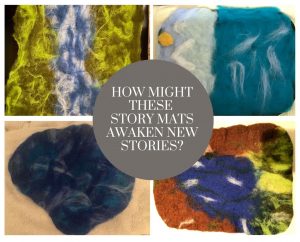
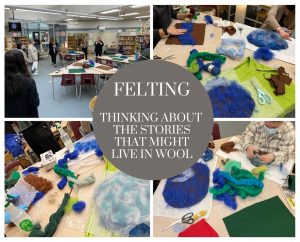
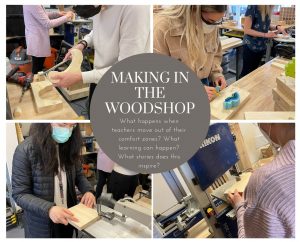
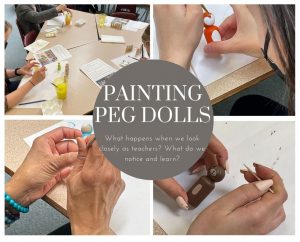
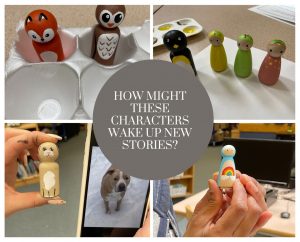
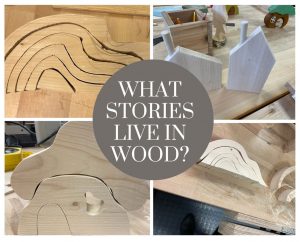
Photos (above): Photo collages of teacher making sessions, both process and product.
Taking Action: We decided to work collaboratively in the library, and in classrooms, using the Story Workshop model. The teacher librarian and classroom teachers met regularly to plan next steps based on what we were observing with our students and their writing. The teacher librarian chose texts to use as provocations in consultation with classroom teachers. We shared and reflected on documentation, photos and videos, with each other and with our learners.
Loose parts were always available during Story Workshop. We introduced water colours, water colour pencils, drawing pencils, fine liners, as well as water colour paper and drawing paper. Plasticine was also used to create settings, characters and develop details. We noticed that the affordances of these materials allowed students to capture stories that were important to them. We believe that many of these stories would not have been shared otherwise.



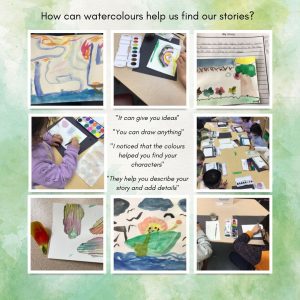
Photos (above): Photo collages of students using watercolours and plasticine in Story Workshop along with guiding questions and reflections.
In a grade 3/4 class, students chose a story to publish and we used the Book Creator iPad app. Students shared these stories at our student led conferences at the end of April with their families. Students were actively engaged and excited about the publishing process and product. We printed copies of their books for the library and other students we actively engaged with this display, reading the stories and asking if the books could be borrowed.
Photos (above): Publishing our stories – Photo collage of students using iPads to publish stories as well as students with their stories in the library and the display.
Checking: At the end of the school year, we asked the same students the four key questions. These students now said they enjoyed writing and saw themselves as authors. They could identify the next steps they wanted to take in their journey as writers. All these students could identify at least two adults in the school who believed they would be a success in life. In one student conference we looked back at some writing that was done at the beginning of the year when the student struggled to write independently, and said he did not like writing. Then we looked at some of his current writing and he said, “I don’t even know what that says. Now everyone can read [my writing] and I can read it, too!”
Other classes entering and observing what was happening in the library were curious and excited about Story Workshop and the Story Studio, particularly intermediate classes. They often asked, “When can we do this?” Although these classes were not officially part of the original Community of Practice they also participated through poetry writing, photography and stop motion animation in the library. These were collaborations based in the philosophies of story workshop.
Reflections/Advice: When we met at the end of the year we reflected on how much joy and gratitude we had for this inquiry. These were some of our reflections:
Strengths/Highlights
- Students independently recording their stories
- Collaboration with Teacher Librarian and each other essential
- Using books as provocations and mentor texts successful
- Students choosing to write in explorations
- Parents noticing how much writing students are doing
- Kids found stories that matter to them
- Kids asking to have books photocopied to give away
- Descriptive words come naturally with story workshop
- Students are discovering their voice and developing self confidence
- Students are using their imaginations with the materials and those with limited language can use materials and writing to tell their story
- Poetry has been a good entry point for reluctant writers
- Reluctant writers are motivated to write but need patience
Stretches/Challenges/Wonders
- Process vs product: Does it matter if they finish their story?
- How can we have a resource team with ELL and LSS support SW?
- How can we use multiple spaces for story workshop with multiple classes?
- How do you move from play to writing? Knowing the right nudge
Possibilities for Next Year
- Dive deeper into our Story Workshop book and have book club meetings
- Maintain our Story Workshop Community of Practice
- Creating a digital aesthetic? (green screens)
- Decolonization of story? Explore and connect First People’s Principles
- Organizing classroom materials in carts


